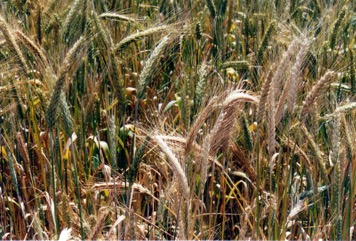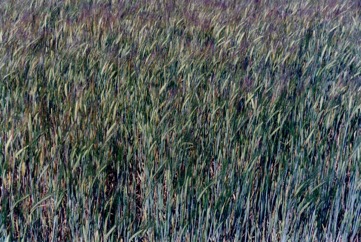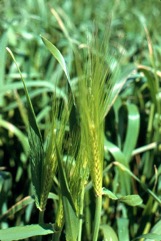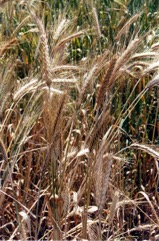Barley, Pearl Barley, Six Rowed Barley

It is a temperate plant. It requires full sun and well-drained soil. It can tolerate saline conditions. In Nepal it grows to 3500 m altitude. It grows in the mountains in Java. In Ethiopia it grows between 1,800-4,000 m above sea level.
Also known as:
Barleycorn, Barlibiyam, Barliyarisi, Bori, Byit-gyon, Cebada, Cabada forrajera, Gerste, Gota, Gyon-saba, Jaab, Jab, Jaon, Jau, Jav, Java godhi, Java, Jmvah, Jowakhar, Ma-yaw, Mai ya, Naked barley, Nas, Navadni ječmen, Orge, Orzo, Oua, Taangbuang, Tangbuang, Yava, Yavaka
Synonyms
- Hordeum sativum Pers.
- Hordeum aegiceras Nees ex Royle
- Hordeum agriocrithon A. E. Aberg
- Hordeum agriocrithon var. dawoense A. E. Aberg
- Hordeum coeleste var. trifurcatum Schltdl.
- Hordeum deficiens Steud. ex A. Braun
- Hordeum deficiens var. nudideficians (Korn.) Harlan
- Hordeum deficiens var. steudelii (Korn.) Harlan
- Hordeum deficiens var. tridax (Korn.) Harlan
- Hordeum distichon L.
- Hordeum distichon var. abyssinicum Ser.
- Hordeum distichon var. erectum Schubl.
- Hordeum distichon var. ianthinum Korn.
- Hordeum distichon var. nigricans Ser.
- Hordeum distichon var. nudideficiens Korn.
- Hordeum distichon var. nudum L.
- Hordeum distichon var. nutans Schubl.
- Hordeum distichon var. palmella Harlan
- Hordeum distichon var. persicum Korn.
- Hordeum distichon var. tridax Korn.
- Hordeum hexastichon L.
- Hordeum irregulare A. E. Aberg & Wiebe
- Hordeum polystichon Haller f.
- Hordeum polystichum var. trifurcatum (Schltdl.) Asch. & Graebn.
- Hordeum pyramidatum R. E. Regel
- Hordeum sativum Jess.
- Hordeum tetrastichum Stokes
- Hordeum tetrastichum var. aethiops ined.?
- Hordeum vulgare cv. trifurcatum (Schltdl.) Alef.
- Hordeum vulgare subsp. deficiens (Steud. ex A. Braun) A. Love
- Hordeum vulgare subsp. interjectum Flaksb.
- Hordeum vulgare subsp. intermedium Korn.
- Hordeum vulgare var. aethiops Korn.
- Hordeum vulgare var. afghanicum Vavilov ex N. A. Ivanova
- Hordeum vulgare var. coeleste L.
- Hordeum vulgare var. coerulescens Ser.
- Hordeum vulgare var. cornutum Schrad.
- Hordeum vulgare var. deficiens (Steud. ex A. Braun) Korn.
- Hordeum vulgare var. duplinigrum Korn.
- Hordeum vulgare var. himalayense (Schult.) Korn.
- Hordeum vulgare var. horsfordianum Wittm. ex Harlan
- Hordeum vulgare var. leiorrhynchum Korn.
- Hordeum vulgare var. nigricans (Ser.) Korn.
- Hordeum vulgare var. nigrum (Willd.) Peterm.
- Hordeum vulgare var. nudum Spenn.
- Hordeum vulgare var. pallidum Ser.
- Hordeum vulgare var. rikotense R. E. Regel
- Hordeum vulgare var. steudelii Korn.
- Hordeum vulgare var. tetrastichon Celak.
- Hordeum vulgare var. violaceum Korn.
- Hordeum ?intermedium (Korn.) Carleton
- Hordeum ?intermedium var. cornutum (Schrad.) Harlan
- Hordeum ?intermedium var. haxtonii Korn.
- Hordeum ?intermedium var. mortonii Korn.
- Hordeum ?intermedium var. nudihaxtonii Korn.
- Hordeum zeocrithon L.
Edible Portion
- Seeds, Cereal, Seeds - tea
Where does Barley grow?
Found in: Afghanistan, Africa, Albania, Andes, Andorra, Argentina, Asia, Australia, Azerbaijan, Bangladesh, Bolivia, Brazil, Britain, Canada, Canary Islands, Caucasus, Central Africa, Central Asia, Chile, China, Congo, Cuba, Cyprus, Czech Republic, East Africa, Egypt, Eritrea, Ethiopia, Europe, Finland, France, Georgia, Germany, Greece, Himalayas, India, Indochina, Indonesia, Iran, Iraq, Isle of Man, Israel, Italy, Japan, Kazakhstan, Kenya, Korea, Kurdistan, Kyrgyzstan, Liechtenstein, Madagascar, Mali, Mauritania, Mediterranean, Mexico, Moldova, Morocco, Mozambique, Myanmar, Nepal, New Zealand, Nigeria, North Africa, North America, Northeastern India, Norway, Pakistan, Russia, Scandinavia, SE Asia, Serbia, Sikkim, Slovenia, South Africa, Southern Africa, South America, Spain, Sudan, Switzerland, Syria, Taiwan, Tajikistan, Tanzania, Tasmania, Thailand, Tibet, Turkey, Ukraine, Uruguay, United States, Uzbekistan, West Africa, Yemen, Zambia, Zimbabwe
Notes: There are about 20 Hordeum species. It is gluten free.
Growing Barley, Pearl Barley, Six Rowed Barley
Cultivation: Plants are grown from seed. Seed can be planted 2-6 cm deep. Often 200-250 plants are grown per square metre.
Edible Uses: The grains are eaten. They are mixed with wheat for chappatis. They are also used in soups. They are also used for bread and breakfast cereals. They have a low gluten content. The seed are also soaked until they sprout and produces malt. This is used for alcohol production. Caution: Alcohol is a cause of cancer. The sprouted seeds are eaten in salads. Barley water is made by soaking the barley in water and flavouring with lemon. The young seedlings are dried and powdered and marketed as barleygreen. Roasted seeds are added to coffee.
Production: It has a relatively short growing season and matures quickly.
Nutrition Info
per 100g edible portion| Edible Part | Energy (kcal) | Protein (g) | Iron (mg) | Vitamin A (ug) | Vitamin c (mg) | Zinc (mg) | % Water |
|---|---|---|---|---|---|---|---|
| Seed boiled | 122 | 2.7 | 0.2 | 0 | 0 | 0.7 | 69.6 |
| Seeds | 327 | 10.5 | 6 | - | - | - | 13.7 |
Barley, Pearl Barley, Six Rowed Barley Photos




References
Ambasta, S.P. (Ed.), 2000, The Useful Plants of India. CSIR India. p 273
Anderson, E. F., 1993, Plants and people of the Golden Triangle. Dioscorides Press. p 213
Beckstrom-Sternberg, Stephen M., and James A. Duke. "The Foodplant Database." http://probe.nalusda.gov:8300/cgi-bin/browse/foodplantdb.(ACEDB version 4.0 - data version July 1994)
Bianchini, F., Corbetta, F., and Pistoia, M., 1975, Fruits of the Earth. Cassell. p 20
Bodkin, F., 1991, Encyclopedia Botanica. Cornstalk publishing, p 563
Bremness, L., 1994, Herbs. Collins Eyewitness Handbooks. Harper Collins. p 253
Brouk, B., 1975, Plants Consumed by Man. Academic Press, London. p 20 (As Hordeum hexastichon)
Brown, D., 2002, The Royal Horticultural Society encyclopedia of Herbs and their uses. DK Books. p 236
Burkill, H. M., 1985, The useful plants of west tropical Africa, Vol. 4. Kew.
Bussman, R. W., et al, 2016, A comparative ethnobotany of Khevsureti, Samtskhe-Javakheti, Tusheti, Svaneti, and Racha-Lechkhumi, Republic of Georgia (Sakartvelo), Caucasus. Journal of Ethnobiology and Ethnomedicine.
Bussman, R. W. et al, 2017, Ethnobotany of Samtskhe-Javakheti, Sakartvelo (Republic of Georgia), Caucasus. Indian Journal of Traditional Knowledge Vol. 16(1) pp 7-24
Ceccarelli, S. & Grando, S., 2006. Hordeum vulgare L. [Internet] Record from Protabase. Brink, M. & Belay, G. (Editors). PROTA (Plant Resources of Tropical Africa), Wageningen, Netherlands. < http://database.prota.org/search.htm>. Accessed 16 October 2009.
Curtis, W.M., & Morris, D.I., 1994, The Student's Flora of Tasmania. Part 4B St David's Park Publishing, Tasmania, p 297
Dorjey, K., 2015, Exploration of Plant based Traditional Knowledge from Sham region of Ladakh (J. & K.), India. Journal of Plant Development Sciences Vol. 7 (5) : 429-433.
Facciola, S., 1998, Cornucopia 2: a Source Book of Edible Plants. Kampong Publications, p 176
Farfan B., et al, 2007, Mazahua Ethnobotany and Subsistence in the Monarch Butterfly Biosphere Reserve, Mexico. Economic Botany 61(2) pp 173-191
Flora of Pakistan. www.eFloras.org
Gangte, H. E., et al, 2013, Wild Edible Plants used by the Zou Tribe in Manipur, India. International Journal of Scientific and Research Publications, Volume 3, Issue 5
Guite, C., 2016, A study of wild edible plants associated with the Paite tribe of Manipur, India, International Journal of Current Research. Vol. 8, Issue, 11, pp. 40927-40932
Harlan, J.R., 1979, Barley, in Simmonds N.W.,(ed), Crop Plant Evolution. Longmans. London. p 91
Haq, N., Anthony, K., Sarwar, M., and Ahmad, Z. (eds.), 1998, Underutilized Crops of Pakistan. Plant Genetic Resources Institute. p 12
Hedrick, U.P., 1919, (Ed.), Sturtevant's edible plants of the world. p 348 (Also as Hordeum hexastichon)
Heywood, V.H., Brummitt, R.K., Culham, A., and Seberg, O., 2007, Flowering Plant Families of the World. Royal Botanical Gardens, Kew. p 394
Hussey, B.M.J., Keighery, G.J., Cousens, R.D., Dodd, J., Lloyd, S.G., 1997, Western Weeds. A guide to the weeds of Western Australia. Plant Protection Society of Western Australia. p 56
Hu, Shiu-ying, 2005, Food Plants of China. The Chinese University Press. p 290
Hwang, H., et al, 2013, A Study on the Flora of 15 Islands in the Western Sea of Jeollanamdo Province, Korea. Journal of Asia-Pacific Biodiversity Vol. 6, No. 2 281-310
Jardin, C., 1970, List of Foods Used In Africa, FAO Nutrition Information Document Series No 2.p 4
Khanal, R., et al, 2014, Documenting abundance and use of underutilized plant species in the mid hill region of Nepal. ECOPRINT 21: 63-71, 2014
Kiple, K.F. & Ornelas, K.C., (eds), 2000, The Cambridge World History of Food. CUP p 1727
Lamp, C.A., Forbes, S.J. and Cade, J.W., 1990, Grasses of Temperate Australia. Inkata Press. p 184
Lazarides, M. & Hince, B., 1993, Handbook of Economic Plants of Australia, CSIRO. p 134
Malezas Comestibles del Cono Sur, INTA, 2009, Buernos Aires
Paczkowska, G. & Chapman, A.R., 2000, The Western Australian Flora. A Descriptive Catalogue. Western Australian Herbarium. p 109
Pieroni, A., 2008, Local plant resources in the ethnobotany of Theth, a village in the Northern Albanian Alps. Genet Resour Crop Evol (2008) 55:1197–1214
Pieroni, A., 2017, Traditional uses of wild food plants, medicinal plants, and domestic remedies in Albanian, Aromanian and Macedonian villages in South-Eastern Albania. Journal of Herbal Medicine Volume 9, September 2017, Pages 81-90
Plants for a Future database, The Field, Penpol, Lostwithiel, Cornwall, PL22 0NG, UK. http://www.scs.leeds.ac.uk/pfaf/ (Also as Hordeum hexastichon)
PROSEA (Plant Resources of South East Asia) handbook Volume 10 Cereals. p 99
Purseglove, J.W., 1972, Tropical Crops. Monocotyledons. Longmans p 159
Rashid, H. E., 1977, Geography of Bangladesh. Westview p 249 (As Hordeum hexastichum)
Rawat, G.S., & Pangtey, Y.P.S., 1987, A Contribution to the Ethnobotany of Alpine Regions of Kumaon. J. Econ. Tax. Bot. Vol. 11 No. 1 pp 139-147
Ruiters-Welcome, A. K., 2019, Food plants of southern Africa. Ph.D. thesis. Univ. of Johannesburg p 87
Shah, S. K., 2014, Dietary contribution of underutilized minor crops and indigenous plants collected from uncultivated lands and forests in Nepal. in Promotion of Underutilized Indigenous Food Resources for Food Security and Nutrition in Asia and Pacific. FAO. Bangkok
Solomon, C., 2001, Encyclopedia of Asian Food. New Holland. p 24
Song, M., et al, 2013, Traditional knowledge of wild edible plants in Jeju Island, Korea. Indian Journal of Traditional Knowledge. 12(2) pp 177-194 (As var. hexastichon)
Sp. pl. 1:84. 1753 and Sp. pl. 1:85. 1753 (As Hordeum hexastichon)
Tapia, M. E., The role of under-utilised plant species with regard to increased food security and improved health of poor poeople, in mountain regions. IIAP-PNUD/Peru
Tasmanian Herbarium Vascular Plants list p 86
USDA, ARS, National Genetic Resources Program. Germplasm Resources Information Network - (GRIN). [Online Database] National Germplasm Resources Laboratory, Beltsville, Maryland. Available: www.ars-grin.gov/cgi-bin/npgs/html/econ.pl (10 April 2000)
van Wyk, B., 2005, Food Plants of the World. An illustrated guide. Timber press. p 209
van Wyk, Be, & Gericke, N., 2007, People's plants. A Guide to Useful Plants of Southern Africa. Briza. p 10
Vaughan, J. C. & Geissler, C. A., 2009, The new Oxford Book of Food Plants. Oxford University Press. p 6
World Checklist of Useful Plant Species 2020. Royal Botanic Gardens, Kew
Zhang, L., et al, 2016, Ethnobotanical study of traditional edible plants used by the Naxi people during droughts. Journal of Ethnobiology and Ethnomedicine. 12:39